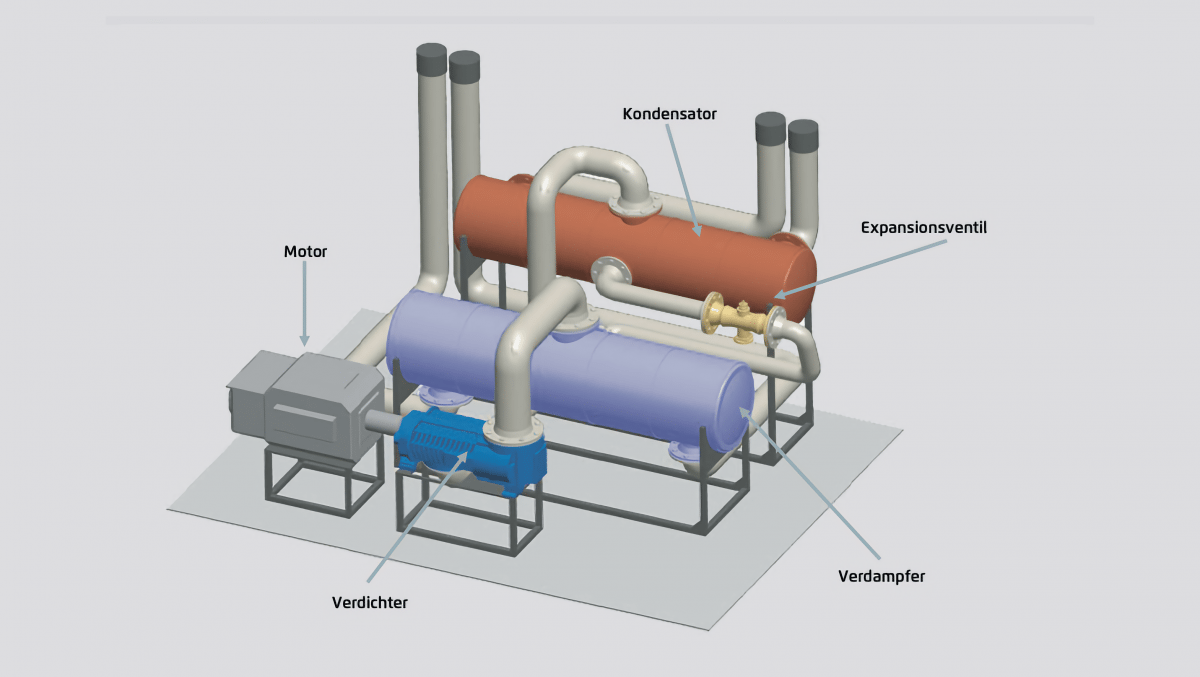“The entire German heat demand of up to 200 degrees Celsius can technically be covered completely by heat pumps.” This is the result of a Fraunhofer study commissioned by the Agora Energiewende. This would save three quarters of German natural gas consumption.
Large heat pumps with an output of 500 kW and above, which draw their heat from geothermal energy, river or lake water, industrial waste heat, waste water or mine water, play a special role in this. According to the study, with flow temperatures of up to 200 degrees Celsius, they could theoretically cover not only the entire need for building heating and hot water, but also a good third of the industrial process heat – at least if you compare the heat requirement and the heat supply.
To do this, however, thermal output of four gigawatts would have to be added annually by 2045. Only 100 MW are currently installed in Germany, another 600 MW are under construction or in planning. In Scandinavia, on the other hand, large heat pumps are already widespread.
Lots of prerequisites
In order to achieve the envisaged expansion, a large number of factors must come together. A technical challenge is to generate correspondingly high flow temperatures. Currently only half a dozen units on the market reach temperatures of over 130 degrees. “Technical innovations in compressors and refrigerants allow performance increases along three central criteria,” says the study: “Firstly, higher target temperatures and temperature rises can be achieved. Secondly, considerable increases in efficiency are possible. Thirdly, greater flexibility can be achieved by operating in broader power ranges and with faster load changes.”
The next hurdle is profitability. The market for large heat pumps is currently “still strongly characterized by customer-specific solutions”. In order to reduce costs, greater standardization and higher quantities are required. This, in turn, is only possible with the right political framework: better funding, faster approvals, more binding targets. The ratio of electricity to gas prices is also crucial. This can be balanced, for example, through emissions trading or time-variable grid fees.
The study sees conflicts above all with combined heat and power plants, which are often operated with natural gas. So far, these have been funded using the same instrument as large heat pumps, namely as “innovative combined heat and power systems” (iKWK) within the framework of the CHP Act. Since September 2022, they have also been funded via the “Federal Funding for Efficient Heating Networks” (BEW).
“The existence of various funding options is unnecessary and inefficient,” write the authors of the study. “For example, system configurations in which the waste heat from a natural gas-based CHP system acts as a heat source for a large heat pump are also eligible for funding via the iKWK tenders. There is a risk here that such incentives will lead to fossil CHP systems being in use longer than necessary remain in operation and the transformation of the heating networks is slowed down. The instrument of iKWK funding in the KWKG is therefore no longer necessary in its current form and would even be counterproductive in some cases.”
Deep geothermal and other alternatives
Since large heat pumps mainly feed into local and district heating networks, another construction site is opening up here: the study estimates that an average of 800 kilometers of new heating routes would have to be built every year by 2045. In 2020, the net increase was 423 kilometers.
In addition, the study calls on the federal government to impose “binding regulations for heat planning and energy distribution strategy” on the municipalities. This means that customers can find out whether and when they can expect to be connected to a heating network, and operators of heating networks can find out which waste heat sources they can use.
At least the last point seems to be progressing. At the district heating summit on Monday, the federal government and the energy industry agreed to expand the heating networks more quickly and to generate half of the district heating in a climate-neutral manner by 2030. In addition, all municipalities with 10,000 or more inhabitants should carry out heat planning. The first step is to determine the demand, i.e. how much heat is required in an area and what heat infrastructure is available. This should be followed by a potential analysis of which different energy sources can be available for the heat supply.
Heat pumps are often not required at all for the heating networks. Deep geothermal energy, for example, often provides sufficiently high temperatures. And low-temperature networks with less than 70 degrees can also use other heat sources such as industrial waste heat directly.

(bsc)
